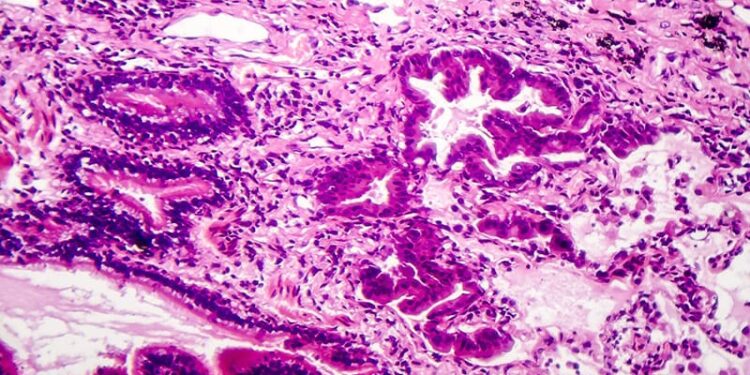BOSTON — Key DNA and chromosomal and immune cell changes in early-stage lung adenocarcinoma show significant associations with outcomes, representing potentially important early predictors to guide management of the increasingly prevalent, deadly disease, according to the results of a new study.
“We found that DNA ploidy and chromosomal structure predict early recurrence in lung adenocarcinoma, identifying high-risk groups,” said first study author Luning Mao, PhD, of Fudan University Shanghai Cancer Center, Shanghai Medical College, Fudan University, Shanghai, China.
Furthermore, low density of macrophages “indicates a favorable prognosis,” reported Mao, at the United States and Canadian Academy of Pathology (USCAP) 2025 Annual Meeting.
In the prevention of recurrence and metastasis in early-stage lung adenocarcinoma, identification of molecular markers is key, however, research relating to the prognostic significance of chromatin structure typing, immune cells, and other factors in early lung adenocarcinoma is lacking.
“In early lung adenocarcinoma, the screening of populations that would benefit from prognosis and postoperative adjuvant therapy remains an urgent issue to be addressed,” said Mao. “Our team sought to address these critical gaps in predicting outcomes.”
To further investigate the prognostic significance of DNA ploidy and nucleotyping, Mao and her colleagues evaluated pathology samples and data on mutations from 164 patients with early lung adenocarcinoma.
Specifically, chromatin structure analysis was performed on lung tissue samples from all 164 of the patients, while a further immune microenvironment heterogeneity analysis was performed on tissue samples of 118 patients.
The researchers first stratified the groups by chromatin homogeneous (CHO, ≥ 0.0952) and c hromatin heterogeneous (CHE, < 0.0952) subtypes, and performed chromatin structure analysis. They found that DNA nondiploid, CHE, and a high tumor-stroma ratio were each significantly related to multiple invasive clinicopathologic parameters including clinical stage, lymph node metastasis, pleural invasion, and tumor progression.
Univariate as well as multivariate Cox analysis further showed that DNA nondiploid and CHE are independent risk factors for recurrence and metastasis of early-stage lung adenocarcinoma and are associated with disease-free survival in early-stage lung adenocarcinoma (P = .009 and P = .004, respectively).
Combined, DNA nondiploid and CHE were further associated with poor disease-free survival (hazard ratio [HR], 3.55; adjusted P = .003).
The most prominent independent risk factors for tumor progression included not receiving adjuvant therapy (P = .057), CHE (P = .02), and the high-risk combination of DNA nondiploid and CHE (P = .024).
Further analysis of immune cell infiltration showed that a high density of macrophages was significantly associated with poor disease-free survival (HR, 2.43; P = .010), as were high-density M1 type macrophages (HR, 2.67; P = .006).
Meanwhile, M1-type macrophages that were located further away from tumor cells were significantly associated with better disease-free survival (HR, 0.44; P = .017).
In discussing the study at the talk, co-moderator Junya Fukuoka, MD, PhD, of Nagasaki University, Nagasaki, Japan, speculated on how the markers might compare with other known markers of lung adenocarcinoma.
“There are other studies showing markers [such as] nuclear protein Ki-67 expression to be known to be associated with a poorer prognosis,” he said.
“It might be [useful] to compare your results with those to try to understand which might be better at predicting survival,” he told Mao.
Lung Adenocarcinoma Rates on the Rise, Mostly in Nonsmokers
A study published last month in The Lancet reported that adenocarcinoma makes up as much as 70% of lung cancer cases among people who have never smoked.
In addition, it has become the dominant subtype of lung cancers in men and in women accounting for 45.6% and 59.7%, respectively, as of 2022.
Those rates were up from 39.0% in men and 57.1% in women just 2 years earlier in 2020.
“A novel finding of our study is the extent to which lung adenocarcinoma has become the dominant subtype since 2005 in the majority of countries we assessed, with increasing risks among younger generations evident,” the authors of that study reported.
“Our findings also show the need for continued monitoring of the changing risk of lung cancer in younger generations, and for future studies that identify possible causal factors in populations for whom smoking is not considered the major determinant of lung cancer,” they added.
The authors of both studies had no disclosures to report.
Source link : https://www.medscape.com/viewarticle/biomarkers-offer-clues-prognoses-lung-adenocarcinoma-2025a10007si?src=rss
Author :
Publish date : 2025-04-01 10:13:00
Copyright for syndicated content belongs to the linked Source.














